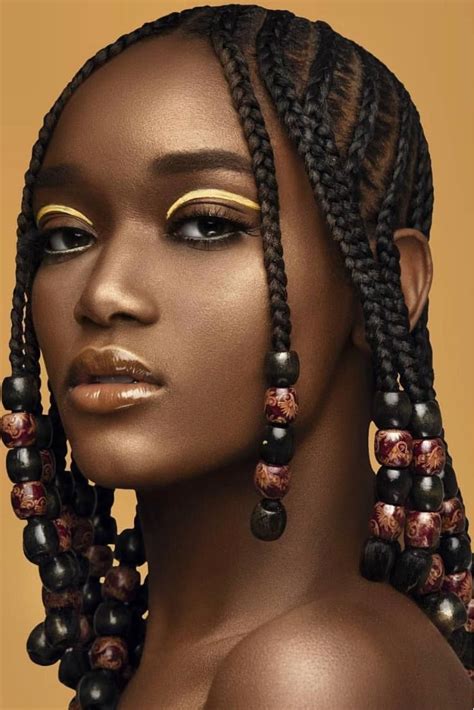African American women have a rich and vibrant history of hairstyling that extends far beyond the confines of beauty salons and hair products. Intricately woven into their cultural heritage, these hairstyles serve as expressions of identity, creativity, and empowerment. In this comprehensive guide, we delve into the captivating world of African American haircut styles for women, exploring their origins, significance, and the myriad of options available today.

Historical Roots of African American Hairstyles
The hairstyles worn by African American women have evolved throughout history, shaped by a blend of African traditions, societal norms, and technological advancements.
African Origins
The hairstyles of West and Central Africa were highly symbolic and varied from region to region. Women adorned their hair with intricate braids, cornrows, and bantu knots, often incorporating beads, shells, and other decorative elements. These hairstyles served both aesthetic and practical purposes, protecting hair from the harsh climate and communicating social status and cultural identity.
Transatlantic Slave Trade and Adaptation
During the transatlantic slave trade, African women were forced to adapt their hairstyles to the demands of their enslavement. Slave owners often prohibited ornate hairstyles, leading women to adopt simpler styles such as head wraps and scarves. Despite these restrictions, African American women found creative ways to maintain their cultural identity through their hairstyles, weaving coded messages and symbols into their braids and buns.
Post-Emancipation and the Harlem Renaissance
Following the abolition of slavery, African American women embraced their liberated hairstyles. The Harlem Renaissance of the 1920s and 1930s saw a flourishing of cultural pride and experimentation. Women experimented with bob haircuts, finger waves, and cornrows, creating a new era of hairstyles that celebrated African American beauty and liberation.
The Dynamic Range of African American Haircut Styles Today
Contemporary African American women have access to a vast array of haircut styles, showcasing the diversity and versatility of their hair texture. From sleek bobs to voluminous afros, every style carries its own unique allure and significance.
Short Cuts
Short haircuts offer a chic and modern look for African American women. Pixie cuts, bob cuts, and fades are popular choices, providing a low-maintenance and versatile style that complements various face shapes.
Medium Length Styles
Medium length styles offer a balance between length and ease of management. Popular options include shoulder-length bobs, lobs (long bobs), and layered cuts, which create volume and movement.
Long Hair
Long hair is synonymous with femininity and grace. African American women can flaunt their long locks in a variety of styles, including cornrows, box braids, dreadlocks, and natural curls. These styles emphasize the beauty and versatility of their hair texture.
Protective Styles
Protective styles prioritize hair health by minimizing breakage and damage. Braids, twists, dreadlocks, and wigs are some of the most popular protective styles, allowing women to retain hair length and protect their natural curls.
Cultural Significance and Identity
African American hairstyles hold profound cultural significance, serving as a symbol of:
Identity and Heritage
Many African American women view their hairstyles as a connection to their heritage and ancestors. Traditional hairstyles, such as cornrows and Afros, pay homage to the traditions of their forefathers.
Resistance and Empowerment
Historically, African American women have used their hairstyles as a form of resistance against social norms and oppression. The Afro, for example, became a symbol of Black pride and empowerment during the Civil Rights Movement.
Beauty and Diversity
African American hairstyles showcase the diversity and beauty of Black hair. They celebrate the unique characteristics of curly, coily, and kinky hair textures, challenging traditional beauty standards.
Choosing the Right Haircut Style for You
Selecting the perfect haircut style depends on several factors, including:
Face Shape
Consider your face shape when choosing a haircut. Short haircuts can complement oval faces, while long hair can elongate round faces. Experiment with different styles to find one that accentuates your features.
Hair Texture
Different hair textures respond differently to various haircutting techniques. Thicker, coarser hair may require more blunt haircuts, while finer, softer hair can handle layers and curls.
Lifestyle
Consider your lifestyle when selecting a haircut. Short haircuts are easier to maintain, while longer styles may require more time and care. Choose a style that fits into your daily routine.
Common Mistakes to Avoid
Avoid these common mistakes when considering African American haircut styles:
Over-Processing
Over-processing hair with chemical treatments can damage its health and weaken its structure. Limit the use of harsh chemicals and opt for natural hair care products.
Ignoring Hair Texture
Not considering your hair texture can lead to disappointing results. Choose a haircut that complements your natural curl pattern and texture.
Lack of Maintenance
Regular maintenance is essential for keeping African American hairstyles looking their best. Schedule regular trims, deep conditioning treatments, and protective styling to maintain healthy hair.
Effective Strategies for Hair Care
Maintain healthy and stylish hair by following these effective strategies:
Hydration is Key
African American hair tends to be dry, so regular hydration is crucial. Use moisturizing shampoos, conditioners, and leave-in treatments to replenish moisture.
Protective Styling
Protective styles minimize breakage and damage. Alternate between protective styles and natural hairstyles to maintain hair length and health.
Gentle Combing and Brushing
Use wide-toothed combs and brushes to avoid tangles and breakage. detangle hair when it’s wet and apply a detangler to prevent snags.
Get Regular Trims
Regular trims remove split ends and promote hair growth. Schedule trims every 6-8 weeks to keep your hair healthy and looking its best.
Conclusion
African American haircut styles for women are a testament to the rich culture, creativity, and resilience of the Black community. They encompass a vast range of styles that celebrate diversity, embrace heritage, and empower women. By understanding the historical roots, cultural significance, and practical considerations involved in choosing and maintaining these hairstyles, African American women can continue to showcase their unique beauty and inspire others.
